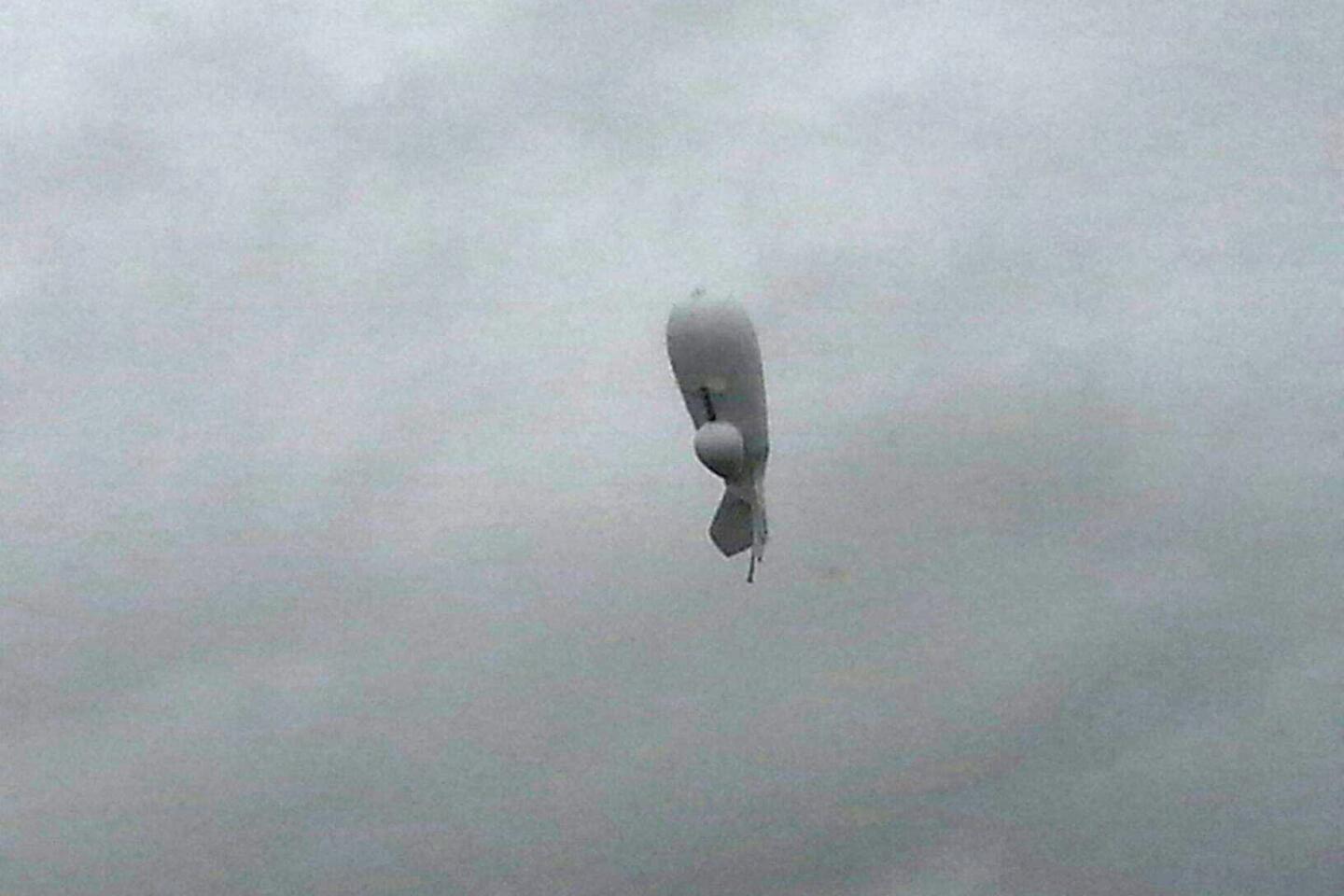Tests find that the Pentagon’s radar blimps can’t track ‘some high priority targets’
In the latest sign of trouble with the Army’s radar-carrying JLENS blimps, tests have found that the system had trouble conveying accurate, timely information about potential airborne threats, according to a new report by the Pentagon’s testing arm.
The problem “could result in some high priority radar targets not being processed and tracked,” the report says.
The JLENS system is designed to protect the U.S. homeland and American troops in the field by providing early detection of cruise missiles, drones and other low-flying threats. The system, in development since 1998, has cost taxpayers $2.7 billion but has not performed as promised.
See more of our top stories on Facebook >>
The problem identified in the new Pentagon report involves software that is supposed to quickly process data from the blimps’ powerful surveillance radar.
In a terse summary of its findings for the 2015 fiscal year, the Pentagon’s Operational Test and Evaluation office said testing of JLENS found “problems related to the timely passing of unambiguous radar track information.”
Congress needs to send a clear message and zero out this program.
— Rep. Jackie Speier (D-Hillsborough), House Armed Services Committee
The software incorporates special features to deal with “very high target densities,” according to the report. But the software was designed in such a way that it excludes “certain target sets,” the report says, without elaborating.
Several military specialists said the language suggests that the system struggled to pick out potential threats among clusters of airborne objects and also had difficulty distinguishing friendly aircraft from threatening ones. Both are capabilities essential to JLENS’ mission.
Overall, the report says, JLENS’ “system-level reliability, both software and hardware, is not meeting the program’s goals.”
The annual report by the Pentagon test office assesses more than 100 weapons systems and is prepared for the secretary of Defense, other top military officials and members of Congress.
Asked about the JLENS-related findings, an Army spokesman, Dov Schwartz, said technicians had installed revised software in the fall in an attempt to fix the problems affecting the radar data.
The installation was done just before a JLENS blimp broke away from its mooring at the Army’s Aberdeen Proving Ground in Maryland on Oct. 28, Schwartz said.
The blimp flew uncontrolled for hours, damaging power lines with its mile-long tether and disrupting aviation before coming to ground 150 miles away in rural Pennsylvania. The episode briefly made JLENS an object of national ridicule and renewed doubts that it would fulfill its mission.
The runaway blimp was one of two that were conducting aerial surveillance to protect the Washington region, part of a three-year “operational exercise” to test JLENS’ capabilities and readiness.
After the accident, the exercise was suspended. If it is resumed, “JLENS evaluators will be in a better position to validate whether or not the [software] updates meet reliability goals,” Schwartz said.
JLENS, short for Joint Land Attack Cruise Missile Defense Elevated Netted Sensor System, was developed for the Pentagon by Raytheon Co.
The system relies on pilot-less blimps, each 242 feet long and loaded with radar gear, that hover at altitudes of up to 10,000 feet. At that height, according to Raytheon, the radar can see 340 miles in any direction, far beyond the limits that Earth’s curvature imposes on land- or sea-based radar.
The blimps are designed to operate in pairs. One searches the skies for threats. The other is supposed to focus on selected airborne objects and transmit “fire control” data on their location, speed and trajectory. That data would guide U.S. fighter jets or ground-fired rockets to destroy an incoming weapon.
The Pentagon test office had previously described JLENS as unreliable. Its 2012 annual report gives JLENS low marks for its ability to find and track targets and to distinguish friendly aircraft from real threats. The report also cites “software stability” problems affecting the fire-control radar. The office’s 2013 report notes similar deficiencies.
The findings from the latest report emerge as Defense Secretary Ashton Carter is seeking renewed congressional support for JLENS.
Carter wants Congress to provide more funding — his aides have put the figure at $27 million — to send two blimps airborne again as soon as possible at Aberdeen. That money would be on top of the $45.5 million for JLENS included in President Obama’s latest proposed budget for the fiscal year that begins Oct. 1.
Rep. Jackie Speier (D-Hillsborough), a member of the House Armed Services Committee, called JLENS “a failed program’” and said she would “fight to eliminate it.”
“We know it doesn’t work,” Speier said in a statement this week. “We know that in high winds another JLENS [blimp] is liable to get loose and do millions of additional dollars in property damage. Congress needs to send a clear message and zero out this program.”
Philip E. Coyle III, a former director of the Pentagon test office who was also a science advisor in the Obama White House, said the JLENS operational exercise should be scrapped.
Coyle said in an interview that JLENS should be downgraded to “research-and-development” status while engineers address its deficiencies.
“It’s not ready for prime time,” he said.
Twitter: @DWillmanNews
ALSO
Former Mexican president on Trump: ‘I’m not going to pay for that f------ wall’
While it defies U.S. government, Apple abides by China’s orders — and reaps big rewards
South Carolina black voters say they know Hillary Clinton well enough to pass on Bernie Sanders
More to Read
Start your day right
Sign up for Essential California for news, features and recommendations from the L.A. Times and beyond in your inbox six days a week.
You may occasionally receive promotional content from the Los Angeles Times.








